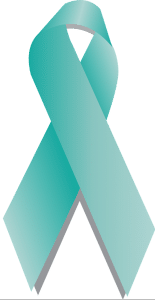They are frightening statistics, but important ones to know: approximately 21,750 women receive a new diagnosis of ovarian cancer each year, and of those diagnosed, 13,940 women die from the disease. In fact, according to the American Cancer Society, this type of cancer is the fifth deadliest cancer among women. In order to increase your chances of survival, you need to know the warning signs and symptoms of ovarian cancer, and seek help immediately if you are experiencing any of them. Because March is Ovarian Cancer Awareness Month, it is the perfect time to discuss the different types of ovarian tumors, common (and some not so common) symptoms, and the risk factors.

Ovarian Cancer Explained
1 in 78 women in the U.S. will be affected by ovarian cancer. Cancer develops when the cells in your body begin to grow abnormally, which can happen anywhere in the body, including in the ovaries. Abnormal cells multiply in one or both ovaries and form a tumor that can spread to other parts of the body if left untreated. Tumors can be malignant, which means they are cancerous, or benign, meaning not cancerous. Benign tumors do not spread throughout the body, but stay in one place and grow over time.
There are different types of tumors that can develop in the ovaries, as well as different risk factors that can contribute to a woman developing ovarian cancer.
Different Types Of Ovarian Tumors
Ovaries are made up of 3 different types of cells, any of which can develop a tumor. These 3 different types of ovarian tumors are:
- Epithelial tumors form in the layer of tissue on the outside of the ovaries. They are the most common type of ovarian tumor and the most likely to be malignant.
- Stromal tumors develop in the structural hormone-producing cells that hold the ovary together. About 7% of ovarian cancers are stromal tumors.
- Germ cell tumors develop in the ova (egg-producing cells) and are usually benign. Germ cell tumors are rare, with the malignant variety making up less than 2% of all ovarian cancers.
Early Signs & Symptoms
One of the reasons that ovarian cancer can be life-threatening is

that some of the early signs are often overlooked. Once the cancer develops, it can spread throughout the abdomen before it causes any concerning symptoms. By the time more serious symptoms are present, the cancer is at a more advanced stage and will be much more difficult to treat. The early signs of ovarian cancer include persistent:
- Bloating, pressure, and pain
- Abnormal fullness after eating
- Pelvic or abdominal pain
- Difficulty eating
- Increase in urination or an increased urge to urinate
- Fatigue
- Back pain
- Pain during sexual intercourse
- Constipation
- Changes in menstrual cycle
- Heartburn
It is important to note that ovarian cysts, which are usually a normal part of ovulation, can develop around the ovary and are not cancerous. If a cyst forms when you are not ovulating, you should get checked as soon as possible. If it does not go away, your doctor might recommend surgery to remove it and determine if it is cancerous.
Risk Factors

The exact cause of ovarian cancer is not yet known, but there are some risk factors that mean you are more likely to develop ovarian cancer. You are at higher risk if you:
- Are older – most ovarian cancers develop after menopause
- Are overweight
- Smoke
- Have a family history of ovarian cancer
- Have inherited a gene mutation (BRCA1 or BRCA2)
- Are of Eastern European Jewish descent
- Have never been pregnant
- Have had fertility treatments such as IVF
- Had your first full-term pregnancy after the age of 35
- Have had endometriosis
- Have had breast, uterine or colorectal cancer
Lowering Your Risk
While there are no real proven ways to completely avoid developing ovarian cancer, you can lower your risk by:
- Taking oral birth control

Breastfeeding can help lower your risk of ovarian cancer. - Becoming pregnant for the first time before the age of 35
- Breastfeeding
- Having surgery on your reproductive organs, such as a hysterectomy or tubal ligation
If you are at high risk for developing ovarian cancer, you can be genetically tested to determine whether you have a mutation in your genes. This will help to catch any diagnosis early on. The best way to beat ovarian cancer is to diagnose it early, before it reaches stage 3 or 4.
If ovarian cancer runs in your family, or if you are in a high risk group, then you need to stay on top of your health, and your insurance coverage, so you know you will be able to be tested and treated, if need be. Not having insurance can end up costing you thousands of dollars, if not more. The last thing you need on top of an ovarian cancer scare, or a diagnosis of cancer, is a large medical bill. If you are concerned about getting tested and want to make sure that you can see the proper specialists, EZ.Insure can help make sure you have the right plan that will cover you.
We work with the top-rated insurance companies around the country and will compare all available plans in your area. Our mission is to find the best plan that will save you the most money. Let us take on the responsibility of finding a comprehensive plan that will meet all of your needs. To get free instant quotes, simply enter your zip code in the bar above, or to speak to an agent, call 888-350-1890.